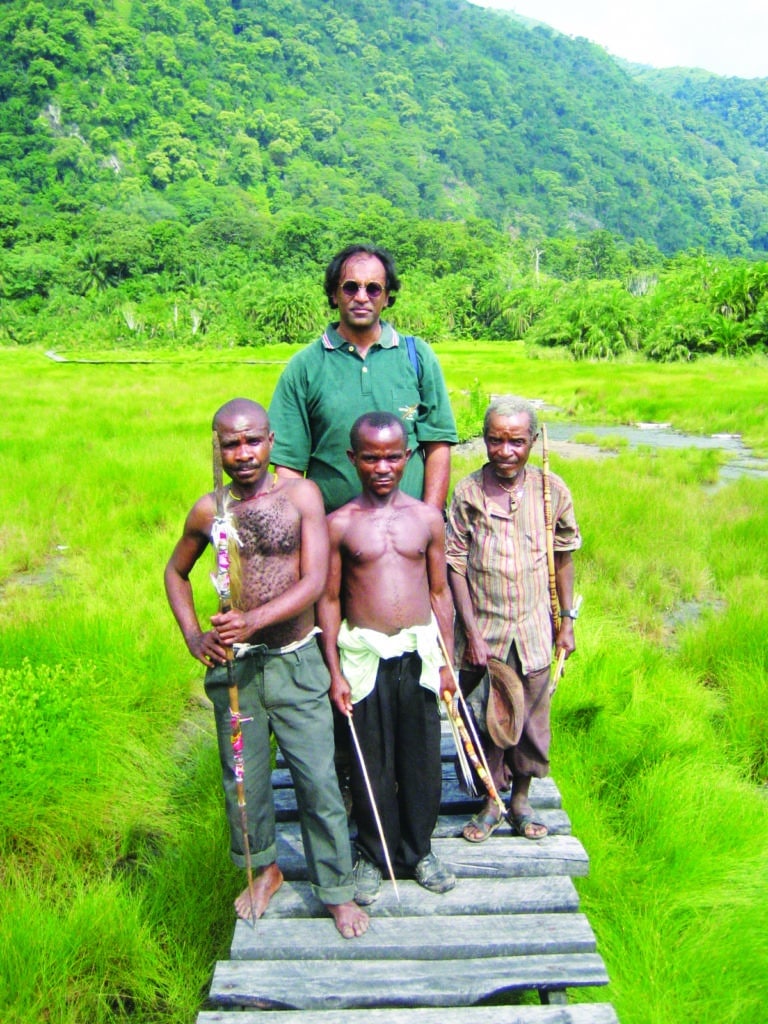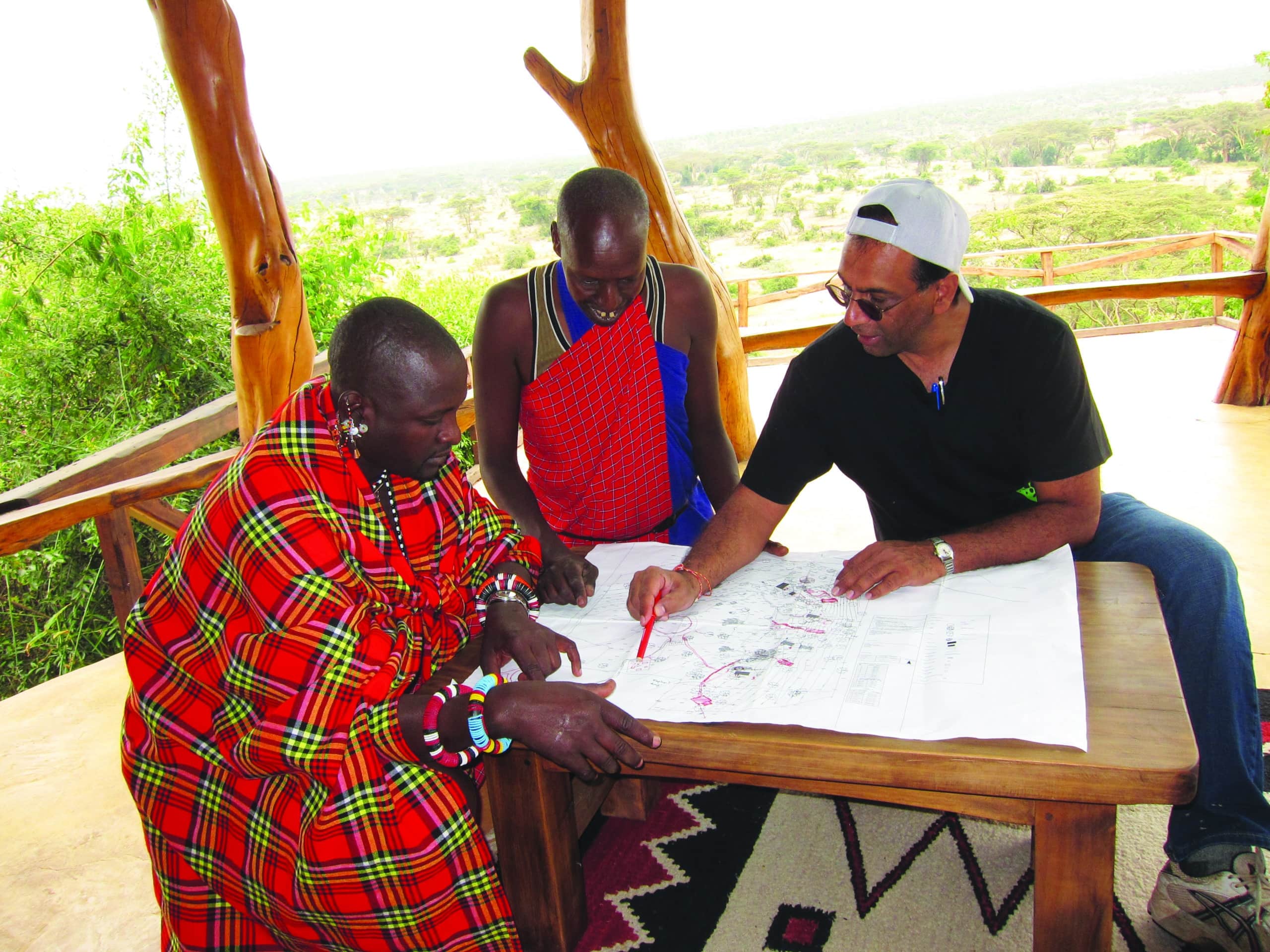An exclusive interview with renowned Kenya-born land- scape architect and pioneer of sustainable tourism Hitesh Mehta. His other fascinating career? Representing East Africa and Kenya in first-class cricket and playing in three ICC World Cup tournaments in the late 1970s and 1980s.
A global authority on sustainable tourism, including the planning and design of eco-lodges in Africa, Hitesh Mehta wears Africa on his sleeve. He is also credited with creating environmental- and social- friendly master plans for many national parks and protected areas on the continent.
This writer first met Mehta at a lecture, Africa–The First World, in Miami, Florida, where he spoke about the achievements of Africa and its inhabitants over the course of several millennia.

Mehta with the Batwa tribe of Semiki forest in western Uganda (image supplied)
Mehta was born in Nairobi of Indian parents, and attended the University of Nairobi where he obtained a degree in architecture in 1985. After receiving the Aga Khan Scholarship, he attained a master’s degree in landscape architecture from the University of California, Berkeley, in 1989. Furthermore, he also represented East Africa and Kenya in first- class cricket and played in three ICC World Cup tournaments in the late 1970s and 1980s as an all-rounder. Mehta has consulted in 67 countries across six continents and is a recipient of multiple international awards for the physical planning of protected areas, for building design, site-planning, and landscape architecture. He shares more highlights in this interview with FORBES AFRICA:
Loading...
Q. You have had an amazing career as a landscape architect especially working in Africa with national parks to create a sustainable tourism environment. How do you define landscape architecture?
A: Landscape architecture involves the planning, design, management and nurturing of built and natural environments in an eco-friendly manner. Everything outside a closed environment, for example, a building, is landscape architecture: plazas, gardens, campuses, national parks, and other protected areas.
Q. What inspired you to choose this profession, which is relatively a new profession compared to the architecture of buildings?
A: Typically, training in architecture schools involves the design of buildings, interiors, and elevations. I realized that it was important for me to understand ‘outside’ areas to be a conscious designer. My education in Berkeley, a leader in the field at that time, helped me become a holistic designer where I could design the inside and outside at the same time.
Q. Has growing up in Africa had an impact on your work?
A: Tremendously! I grew up close to a forested area in Nairobi where visits from small mammals and sightings of leopards were common. Growing up in Africa, I was exposed to material poverty and that made me truly understand what it took to survive and live off the land. Five years after starting my office, I realized that architecture is not about building glitzy structures for the rich but about creating sustainable livelihoods for those who are marginalized and underprivileged. This realization has led me to work with over 30 indigenous peoples the world over.
Q: You have worked in many countries on behalf of the World Bank, International Finance Corporation (IFC), United States Agency for International Development (USAID), German Corporation for International Cooperation (GIZ), National Geographic, International Union for Conservation of Nature (IUCN), African Wildlife Foundation, to name a few. What projects have you done in Africa lately?
A: I am currently working on several projects; in Liberia and in Kenya. My firm HM Design is creating a protected area master plan for the East Nimba Nature Reserve, in northern Liberia.
The key aspects of the projects include the protection of endangered species such as the western chimpanzee, the sustainable development of local people, and ecotourism. In addition, we are designing ‘One Health’ centers, a concept initiated by One Health Alliance and the Food and Agriculture Organization, for the stewardship of the health of humans, animals and plants.
We are also working with USAID on a master plan for the Sapo National Park in Liberia, one of the most biologically-rich rainforests in the world.
In Kenya, we are working with the Maasai communities and conservation NGOs to create a Visitor, Research, Information and Sustainability Center in the two most important ecosystems – the Amboseli National Park and Maasai Mara Game Reserve. Currently, we are also creating a Maasai Mara Sustainability Center with support from the Oliveseed Foundation to educate Maasai women by creating a library and a sustainability center in Kenya. We are also creating a community center for the Noonkotiak Maasai community in partnership with the African Conservation Center headed by Dr David Western, the former head of the Kenyan Wildlife Service.
Q. You were given an outstanding achievement award by United Nations’ bodies for the alleviation of poverty and for protecting sensitive environments. Can you please tell us about some of your work in that respect?
A: In my work around the world, especially while working in protected areas, the people who are most impacted are the local communities whose needs must be met in any such projects. The award that you mentioned was for my work in protected areas, especially in Africa, such as in the Nyungwe National Park, Africa’s largest montane forest, in Rwanda and the Virunga Massif, shared by the Democratic Republic of the Congo, Rwanda and Uganda.
Q: I understand that Nyungwe National Park in Rwanda and Bale Mountains National Park in Ethiopia have been recently named as World Heritage Sites by the United Nations Educational, Scientific and Cultural Organization (UNESCO). What was your contribution to these projects?
A: I am so thrilled that these parks have been recognized by UNESCO. I prepared the physical master plans for both places. In Nyungwe, this included the protection of mammal species such as chimpanzees and helping benefit local communities by creating an investment apparatus for local entrepreneurs. The Bale Mountains National Park in Ethiopia is high plateau at over 11,000ft which I refer to as the Tibet of Africa. My company HM Design prepared the ecotourism master plans which were part of the World Heritage Site package that was submitted to UNESCO. Both Nyungwe and Bale are amazing natural treasures, and I am so proud to be associated with these parks.
Q: Your book Authentic Ecolodges published by HarperCollins is a coffee-table publication; how did you manage to compile material for this project?
A: It all began with me preparing a ‘how to’ technical guidelines book on eco-lodges in 2002. This book, International Ecolodge Guidelines, was widely received by the ecotourism community, so I set about using the criteria set in the book to publish visual, exemplary examples of authentic eco-lodges around the world. The book highlights 36 properties from the 46 countries that I visited and evaluated for publication.
Q: You have designed many of the properties that I have visited by chance the world over. But what fascinates me even more is your life as an international cricketer. What were some of your crowning moments?
A: I first started playing cricket for East Africa at the age of 17, even before I played for my country, Kenya! All this was whilst still in high school. My crowning moment was when I captained the Kenyan team in 1987.
The first cricket bat (Slazenger) that Kapil Dev owned was given as a gift to him from me in 1977. He later signed a huge contract with the bat manufacturer and used a Slazenger bat during India’s successful run to win the World Cup in 1983.
In a three-day game in 1977 and before Kapil Dev had played for India, he borrowed my bat and then proceeded to hit me for three sixes… I also bowled five consecutive maidens against Sunil Gavaskar but he went on to score a double-century!
Loading...
